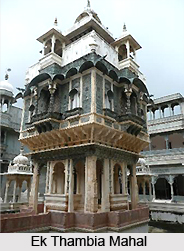 Dungarpur was established in 1282 A.D. by Rawal Veer Singh. The rulers of Dungarpur were Sisodyas who broke away from the Mewar Kingdom in 12th century. The royal residence of the Sisodiyas is exquisitely carved and is built in stone in a style that was developed during the reign of Maharawal Shiv Singh. This southern most part is known as Vagad region. It is well known for its wilderness and also for fertile plains of alluvial soil. Local attractions at Dungarpur comprise of the Udai Bilas Palace and the Juna Mahal. These buildings represent a veritable example of the Rajput architecture.
Dungarpur was established in 1282 A.D. by Rawal Veer Singh. The rulers of Dungarpur were Sisodyas who broke away from the Mewar Kingdom in 12th century. The royal residence of the Sisodiyas is exquisitely carved and is built in stone in a style that was developed during the reign of Maharawal Shiv Singh. This southern most part is known as Vagad region. It is well known for its wilderness and also for fertile plains of alluvial soil. Local attractions at Dungarpur comprise of the Udai Bilas Palace and the Juna Mahal. These buildings represent a veritable example of the Rajput architecture.
The Udai Bilas Palace is carved out of grey blue stone and was built in the late 18th century. This palace is surrounded by Gaibsagar Lake on its three sides. The Aravalli ranges also make the place more picturesque. It is an embodiment of the old world charm of princely India. Presently Udai Bilas Palace has been converted to a heritage hotel. Another attraction within this palace is the Ek Thambia Mahal (One Pillared Palace). Situated in the middle of an inner courtyard this palace has been excellently carved. The lower level is decorated with intricate friezes, columns and arches but the second floor is more beautiful with decorative bracketed windows and sculptured pillars.
Juna Mahal is the oldest royal palace in Dungarpur that dates back to 13th century. The palace has seven storeys and the building has been constructed with the help of bluish gray pareva stone. This material is available locally. Its interior apartments are embellished with beautiful frescoes, the glass and mirror work and miniature paintings. The windows and the balconies command lovely view of the town below and its exquisitely crafted temples on the lake bank. A jewel of the Sheesh Mahal is situated in one of these floors.
Gaibsagar Lake provides the tourists with an opportunity to witness a variety of birds that also include migratory birds. Painted storks, herons, egrets, grey partridge and saras can be spotted. At a distance of 25 kilometers from Dunagarpur 12th century Deo Somnath is situated. It is a complex that is decorated with temple ruins.



















